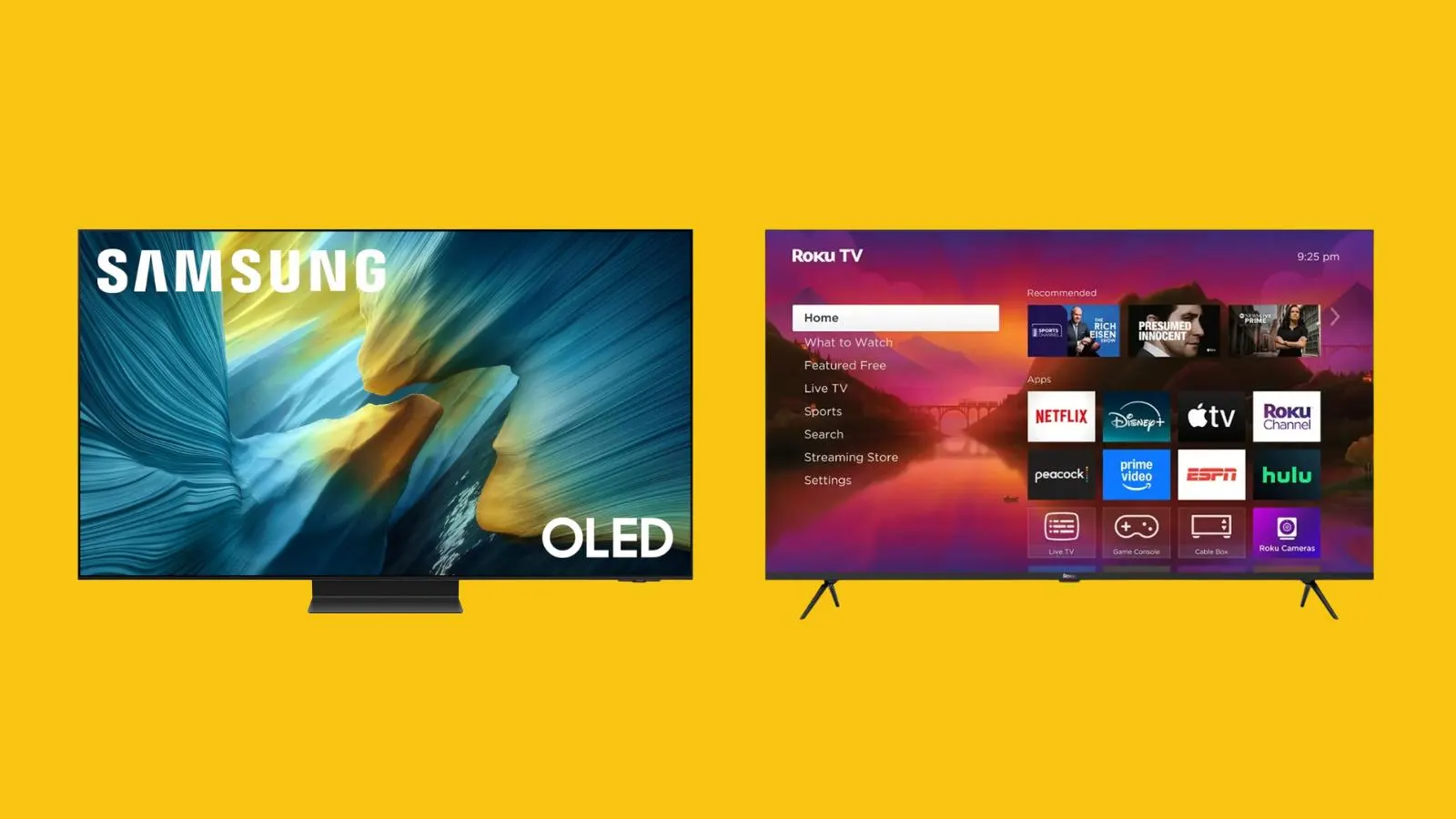By A Home Entertainme,Forbes Staff,Rebecca Isaacs
Copyright forbes

While a good TV can enhance movie night by providing a more detailed picture, the best TVs can now use AI technology to optimize your picture quality frame by frame to really make details pop on-screen. And because there is no shortage of impressive displays on the market, I set out to find the best TV. As the home entertainment expert at Forbes Vetted, after extensive research and hands-on testing with most of the models in this story, I found the best TV to be the Samsung S95F OLED TV. It showcases not only a gorgeous picture with deep contrast, but it also offers useful features like Samsung TV Plus, Samsung’s free ad-based streaming service and the cloud gaming service Samsung Gaming Hub.
These are the best TVs I recommend as Forbes Vetted’s tech editor and home entertainment expert.
Illustration: Forbes / Photos: Retailers
The Samsung S95F OLED TV is a little pricey, but you don’t have to spend thousands on a panel to enjoy a rich picture. My top value option, the Roku Plus Series, comes pre-calibrated—so no need to fiddle with picture settings—and is ideal for casual viewing. That said, if you want a dedicated gaming TV, plan to splurge on the LG G5 OLED TV, an OLED display with sky-high brightness and impressive automatic gaming modes. When researching and testing the best TVs, I took into account picture quality, software features and more. Here are the best TVs I recommend, depending on your needs.
Our Top Recommendations
Best TV Overall: Samsung S95F OLED TV
Best Gaming TV: LG G5 OLED TV
Best Value TV: Roku Plus Series (2025)
Best 65-Inch TV: TCL QM8K QLED TV
Best Lifestyle TV: Samsung The Frame Pro
Best TV Overall
Gorgeous Contrast With An Anti-Glare Coating
Samsung S95F OLED TV
Forbes Vetted
Forbes Vetted ratings are based on thorough evaluations by our editorial team to help you choose the best products with confidence.
Size: 55, 65, 77 and 83 inches | Type: OLED | Resolution: 4K | Refresh rate: 120Hz (165Hz for PCs) | Operating system: Samsung Tizen OS | HDR: HDR10, HDR10+, HLG
What you’ll love:
Impressive levels of contrast
Samsung Tizen is intuitive and includes a dedicated Gaming Hub
Keep in mind:
Anti-glare matte coating comes at the cost of minor contrast degradation
No Dolby Vision
Samsung Vision AI is half-baked, at best
Of all of the TVs I’ve tested this year, the Samsung S95F OLED TV’s slew of features makes it the best overall. Its picture looks stunning no matter the time of day—so long as you take the time to properly calibrate it. Once you do, the display showcases a lovely range of colors, in part thanks to its impressive contrast. Blacks look inky, and because it’s an OLED panel, there’s no blooming, which is when a halo appears around bright images in a dark setting.
While it doesn’t offer Dolby Vision, Samsung’s HDR10 and HDR10+ formats showcase lovely, vibrant colors. The TV operates on Samsung Tizen OS—an intuitive system that puts your streaming apps front and center on the home page. It also offers Samsung’s cloud gaming service, the Samsung Gaming Hub, and Samsung’s free, ad-based streaming channels, called Samsung TV Plus.
There are some minor drawbacks. Samsung unveiled its Samsung Vision AI, a multi-faceted AI software program. The biggest way you may use it is via the dedicated Click to Search button found on the remote. While it can recommend other content and display actors in the shows and movies you’re watching, it’s limited to Samsung TV Plus—you can’t use it on streaming services. If you don’t use it, then it won’t matter to you, and you can safely skip this new AI feature. But if you’re seeking to enhance your viewing experience, it will annoy you. There’s also the anti-glare coating on the TV, which has polarized customers: It’s a love-it-or-hate-it feature because some users feel it degrades the contrast a bit. After testing it, I’m firmly in the “I love it” camp, though. If you’re interested in learning more about this TV, you can read my full Samsung S95F OLED TV review.
Best Gaming TV
This Panel Is So Bright You’ll Want To Grab Your Controller Day Or Night
LG G5 OLED TV
Size: 55, 65, 77, 83 and 97 inches | Type: OLED | Resolution: 4K | Refresh rate: 120Hz | Operating system: LG WebOS 25 | HDR: Dolby Vision, HDR10 and HLG
What you’ll love:
Built for gaming no matter the time of day thanks to its crisp, bright picture
Impressive viewing angles
LG’s Gaming Portal offers cloud gaming with virtually zero lag
Keep in mind:
Weak built-in audio
Modes sometimes don’t automatically enable
The love-it-or-hate-it remote could be a dealbreaker
The LG G5 OLED TV gets sky-high levels of brightness—according to the company, it gets 45% brighter than its predecessor, the LG G4 OLED TV. But what’s more important for gamers is that it’s brighter without feeling like you need to wear sunglasses, and that brightness showcases a stunning contrast. When I tested it as a contender for the best gaming TVs, the LG G5’s picture looked impressive, but I’d recommend ignoring the TV’s AI Picture Pro mode. I’d say that you should spend the time to properly calibrate it instead of using this feature—and plan to make further tweaks if you game. The TV offers a special Game Optimizer mode, but it still needs some minor adjustments to make night scenes in games like Yakuza: Like A Dragon Ishin! pop on the display.
Besides the impressive picture quality, the LG Gaming Portal makes it easy to game in the cloud; as long as you have a stable, speedy internet connection, you can expect virtually no lag. It also offers a 120Hz refresh rate for smooth, responsive gameplay, too. I did find, though, that the remote can be infuriating. It’s an improvement over the LG G4’s remote, but I found the new design still gave me some accidental presses and scrolls, and it frustrated me to no end. Some customers do like the remote, and I can see it being very useful for those with limited mobility, so your mileage may vary. Also, plan to invest in a soundbar: The built-in speakers sound weak under most circumstances and can’t give the deep rumbles during explosion sequences. Furthermore, while the TV offers an AI Sound Pro mode, it makes the audio sound tinny.
Best Value TV
Just Plug And Play This Pre-Calibrated Panel
Roku Plus Series (2025)
Type: QLED | Resolution: 4K | Refresh rate: 60Hz | Operating system: RokuOS | HDR: Dolby Vision, HDR10+, HLG
What you’ll love:
Comes pre-calibrated, so you don’t have to fiddle with your TV settings
Affordable, even in larger sizes
Offers the most intuitive OS system I’ve tested to date
Keep in mind:
Narrow viewing angles
60Hz refresh rate isn’t the best for gamers
For those who want to keep the price of their TV below four figures, the 2025 version of the Roku TV Plus Series is a great option. While the company is best known for its streaming devices, the Roku Plus Series TV is the brand’s take on a fully plug-and-play TV. The company pre-calibrates this model specifically for American audiences, and so there’s no need to adjust picture settings. (Even so, I recommend turning off motion smoothing.)
If you’re a casual TV viewer, the Plus Series TV produces warm and vibrant colors. The Roku OS is most intuitive system I’ve tested to date, with large, easy-to-read widgets front and center on the display. There are a few caveats to consider. It’s a Mini-LED panel, which means it has a narrower viewing angle than an OLED. Expect to see some image degradation if you’re not watching smack dab in front of the display. Additionally, while most TVs on this list offer a 120Hz refresh rate, the Roku Plus Series only offers a 60Hz refresh rate. In short, that means the screen won’t be as smooth as other models, so gamers should look elsewhere.
Best 65-Inch TV
Uses Google TV For Hands-Free Voice Control
TCL QM8K QLED TV
Type: QLED | Resolution: 4K | Refresh rate: 144Hz | Operating system: Google TV | HDR: Dolby Vision, HDR10, HDR10+, HLG
What you’ll love:
Offers both Dolby Vision and Dolby Atmos
Easily the most intuitive OS system I’ve tested to date
Impressive contrast rivals that of OLED
Keep in mind:
Narrower viewing angles than OLED panel
The TCL QM8K QLED TV display size can scale up to 98 inches, but for most folks, its smallest offering, a 65-inch panel, is ideal. The panel offers Google TV OS, and if you misplace the remote, it can also be controlled via Amazon Alexa, Google Assistant or Apple HometKit voice commands. It gets plenty bright for most viewing spaces, and the TV includes an automatic game mode. Another perk? It offers Dolby Vision and Dolby Atmos to enhance the picture and audio quality. This model also offers over 350 free artworks for display when you’re not watching TV, no subscription needed.
The display doesn’t include an anti-glare coating, which means that you may see your reflection on the screen during sunny days. One lovely feature the panel offers is its ZeroBorder design, which minimizes the bezels so that it looks like an infinity display. This design feature makes it feel more immersive when you’re watching movies. Like any QLED TV, while blacks won’t exactly be as inky as an OLED panel, the TCL QM8K gets darn close; its contrast levels are very impressive at this build and price point. For gamers, the TV offers a 144Hz refresh rate to keep your PlayStation 5 gaming frame rates buttery smooth, too.
Best Lifestyle TV
Part Living Room Décor, Part Home Entertainment System
Samsung The Frame Pro
Type: QLED | Resolution: 4K | Refresh rate: 144Hz | Operating system: Google TV | HDR: Dolby Vision, HDR10, HDR10+, HLG
What you’ll love:
Matte display looks lovely when watching content or displaying artwork
Samsung Tizen OS is useful and intuitive
Keep in mind:
Narrower viewing angles than OLED panel
No Dolby Vision
If you are looking for a home entertainment system that melts into the room’s décor, the Samsung The Frame Pro should be your go-to choice. The TV features a matte display that keeps sun glare to a minimum. It comes at the cost of some brightness reduction, but it’s still bright enough that you won’t notice. Colors look stellar on this TV, and during testing I found that colorful scenes in Arcane looked vibrant without feeling oversaturated, which is how the animated sequences should look. Like the other Samsung TVs on this list, make sure you take some time to calibrate the panels. It also uses Samsung Tizen OS, which is intuitive and offers the Samsung TV Plus channels and the Samsung Gaming Hub. While Samsung offers the Samsung The Frame TV, the Pro version has improved HDR. Again, because it’s a Samsung TV, there’s no Dolby Vision, but standard HDR10 and HDR10+ technology keeps the picture vibrant and crisp.
That said, thanks to its QLED panel, you can expect narrower viewing angles. But because it’s a lifestyle TV, you can display art via the Samsung Art Store. Some of the art is free, while some museum collaborations require a subscription—you will have to decide whether that’s worth the investment for your home. But the narrower viewing angle means that this art may be a little distorted. It’s not the end of the world, but it’s worth mentioning—and it’s also worth noting that most lifestyle TVs are plagued with this problem.
RECOMMENDED BY FORBES VETTED
The 6 Best Outdoor TVs I Recommend As A Tech Expert—Just In Time For Football Season
By Rebecca Isaacs
As A Gamer, These Are The 5 Best Gaming TVs That Impressed Me The Most
By Rebecca Isaacs
Why Trust Forbes Vetted
For years, we’ve been testing and reviewing all sorts of screens—and we have our robust library of tech and electronic guides to prove it. By leaning on our hands-on testing and in-depth research, we’ve written dozens of TV stories and compiled tens of gaming roundups, each focused on providing the most up-to-date advice for our readers.
Forbes Vetted consumer tech and electronics editor Rebecca Isaacs is the author of this guide. With more than six years of experience as a tech and home entertainment specialist, she has tested most panels currently on the market. In addition to firsthand testing, she covers many of the latest panel launches, traveling far and wide to get the scoop on the newest display technologies. At times, she has partaken in demonstrations where TVs have been dissected down to their processors and dimming zones to learn about their inner workings.
Forbes Vetted executive editor Dave Johnson, who reviewed this guide, is a veteran tech journalist with decades of experience in the field. He’s authored nearly three dozen books on technology and photography, and like Isaacs, he is well-versed in the latest TV technology. To stay up to date on the latest TV trends, he regularly attends trade shows, like CES.
To supplement our own expertise, we interviewed additional unbiased experts to get their insights on TVs. In particular, we spoke with Avi Greengart, CEO and founder of the technology consultation company Techsponential.
We regularly revisit this story to reevaluate our gaming TV picks and add new testing insights. It was last updated in September 2025 to add all new picks, including our new top pick, the Samsung S95F OLED TV.
How To Choose The Best TV For Your Needs
If you’re shopping for a TV, there are few important features you should understand and consider before adding one to your cart. From display size to TV panel type and more, here’s what to look out for.
If you’re searching for a TV, chances are you’ve seen three major panel types dominating your search. Here’s how to tell them apart.
OLED: This display type consists of millions of self-lit pixels. While they have the best contrast and showcase vibrant colors, they typically don’t get as bright as other market options, so they’re more ideal for dim rooms. They also run the risk of burn-in, which is when you see an area of permanent discoloration on the screen.
Mini-LED: This display type uses millions of Mini-LED lights and, depending on the panel, hundreds or thousands of dimming zones. Because they can get significantly brighter than OLED panels, they’re best for brightly lit rooms. That said, their use of dimming zones means weaker contrast.
QLED: This panel type adds a “quantum dot layer” over a Mini LED panel to enhance the colors and contrast. While this type offers a slightly darker picture, it’s a good balance between OLED and Mini-LED panels.
What you choose depends on your needs and preferences. “It depends mainly on your budget and how contrasted, bright and colorful you are willing to pay for your TV to be,” says Greengart. This especially applies when you want a larger panel, as, “Mini-LED sets are often the most affordable way to get TVs larger than 85 inches that still look good.”
Viewing Angles
When you look at your TV, you want to be able to see every detail directly without any image degradation. While Greengart recommends that you, “Don’t put a TV at an angle from the main viewing position,” you also want to be mindful of your space, too. If you have a wider viewing space, you may want to opt for an OLED, which, thanks to its self-lit pixels, doesn’t experience image degradation. But if you have a smaller space, a Mini-LED or QLED will suit just fine.
Display Size
While many of my top picks range between 55 to 65 inches—the sweet spot for most rooms—sometimes, you want a larger panel. While there’s nothing wrong with wanting to feel more immersed in your viewing, Greengart cautions against going too large. “If you need to sit close to the TV, don’t buy a set where the image will be bigger than what you can see without moving your head from side to side,” he says.
Resolution is the quality of the image on your TV, and it’s usually referred to in pixels. There are three main resolution types on the market right now: 1080p, 4K and 8K. 1080p, or full HD, is the baseline resolution and you’ll find it on budget-friendly and smaller panels. 4K is the latest standard—if you’re going to buy a new TV, I recommend opting for this because it offers significantly sharper details and images on your display. 8K TVs are a step above 4K, and they offer the sharpest details on the market. That said, native 8K content is very limited at best, and these resolutions typically rely on AI upscaling to produce that sharper picture. They also come with a significantly higher price tag for that future-proof image quality, and as a home entertainment expert, I’ve found in my testing that the quality for the price isn’t quite there yet.
HDR Vs. Dolby Vision
The terms HDR and Dolby Vision have probably popped up in your search. If you’re not quite sure what these terms mean, “HDR is a generic term for high dynamic range, which makes highlights on screen much brighter than the rest of the image, which comes closer to matching what we see in the real world, says Greengart. But it gets much more nuanced, according to Greengart. “HDR formats like HDR10 set the brightness and darkness levels once and all of the content then uses those levels.”
Dolby Vision is a dynamic, advanced form of HDR—and it’s used to enhance shadowing and bright scenes to deliver better contrast and colors to your display. While it’s similar to HDR10+, it’s a different technology. “Dynamic HDR formats like HDR10+ and Dolby Vision allow the content owners to adjust the levels as needed throughout the content, which can result in scenes with great shadow detail followed by scenes with tremendous brightness and color,” says Greengart.
So, which is better? It wholly depends on your needs, says Greengart. “Which HDR formats you need will depend on what content you watch and which formats your streaming providers or discs support,” adding that HDR performance trumps resolution to give you a better picture. If you’re a cinephile, Dolby Vision is the ideal choice. HDR10 and HDR10+ are still great for viewing, but it’s better for casual viewers. But it’s also a matter of preference, too, depending on how you prefer your display calibrated.
Operating System
You have plenty of operating systems to choose from. The biggest brands use their own software: Samsung uses its home-grown Samsung Tizen OS; LG uses the LG WebOS. Other brands like TCL and Hisense use Google TV, and of you can find many different TVs offering RokuOS and Amazon Fire. “They vary widely not just in capability but also in ease of use,” says Greengart. “Some have built-in AI assistants, and others opt for simplicity. My favorite OS for simplicity is Roku, followed by Amazon Fire.”
If you don’t like your TV’s operating system, you can always use a dedicated streaming device to use your preferred OS. “My favorite for capability is Apple TV (by connecting an Apple TV box), followed by Google TV OS; and my least favorite is LG’s webOS, which tries to do too much,” says Greengart.
Which Brand Of TVs Are Best?
Based on my testing and research, there are a few brands that are worth the investment. Samsung and LG offer an exceptional picture quality, but you can expect to pay a hefty price tag for them. For a more affordable panel, look at the TCL QM8K QLED TV, with the caveat that it only comes in sizes 65 inches and larger.
Get Up To 30% Off Select Decor And Mirrors
Use By October 6, 2025
Explore Arhaus Coupon
Get Up To 40% Off Select Rugs
Use By October 6, 2025
Explore Arhaus Coupon
Become An Arhaus Trade Member To Earn Commissions And Special Rewards
Use By October 6, 2025
Explore Arhaus Coupon
Get Up To 15% Off Select Kids’ Shoes Sale Styles
Use By October 5, 2025
Explore Timberland Coupon
Open An Archarge Credit Card To Earn $100 In Rewards For Every $1,500 Spent
Explore Arhaus Coupon
Got a tip? Share confidential information with Forbes.
Editorial StandardsReprints & Permissions



